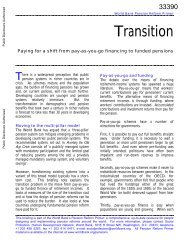Financial Sector Development in Africa: Opportunities ... - World Bank
Financial Sector Development in Africa: Opportunities ... - World Bank
Financial Sector Development in Africa: Opportunities ... - World Bank
Create successful ePaper yourself
Turn your PDF publications into a flip-book with our unique Google optimized e-Paper software.
204 Dafe<br />
<strong>in</strong> the 1980s and 1990s were conditioned by pre-exist<strong>in</strong>g patterns of<br />
state-society <strong>in</strong>teraction, as registered <strong>in</strong> the concentration and ownership<br />
structure of the bank<strong>in</strong>g sector and <strong>in</strong> political alliances between the state<br />
and the bank<strong>in</strong>g sector. The stronger, more diverse, and more autonomous<br />
the private bank<strong>in</strong>g sector was <strong>in</strong> relation to the government, the further<br />
and deeper went the process of reform. Boone’s f<strong>in</strong>d<strong>in</strong>gs are <strong>in</strong> l<strong>in</strong>e with<br />
other works on the determ<strong>in</strong>ants of economic policy mak<strong>in</strong>g <strong>in</strong> the develop<strong>in</strong>g<br />
world. Bräutigam, Rakner, and Taylor (2002), for <strong>in</strong>stance, exam<strong>in</strong>e<br />
the emergence of growth coalitions <strong>in</strong> <strong>Africa</strong> and f<strong>in</strong>d that, <strong>in</strong> countries<br />
where the private sector does not constitute a powerful partner <strong>in</strong> economic<br />
reform processes, government policies are less successful <strong>in</strong><br />
economic restructur<strong>in</strong>g. There is also evidence that <strong>in</strong> develop<strong>in</strong>g countries<br />
with highly concentrated, oligopolistic bank<strong>in</strong>g sectors, f<strong>in</strong>ancial<br />
reforms are not as far-reach<strong>in</strong>g and the privileges of banks are ma<strong>in</strong>ta<strong>in</strong>ed,<br />
because governments try to preserve the political alliances established<br />
with these banks <strong>in</strong> pre-reform periods (Boone 2005; Haggard, Lee, and<br />
Maxfield 1993).<br />
In light of these f<strong>in</strong>d<strong>in</strong>gs on the role of the organization of the private<br />
sector, it seems plausible that activist policies are more likely to succeed<br />
<strong>in</strong> <strong>Africa</strong>n countries where the state is complemented by a diverse and<br />
autonomous private (bank<strong>in</strong>g) sector. There are at least two reasons for<br />
this. First, governments f<strong>in</strong>d it more difficult to exploit the private bank<strong>in</strong>g<br />
sector as a source of f<strong>in</strong>ance for government entities, patronage, or<br />
elections when it is stronger and more autonomous. Governments also<br />
have fewer <strong>in</strong>centives to do so if a developed private sector provides<br />
stable and substantial tax revenues. Second, the political capture of activist<br />
policies by powerful economic <strong>in</strong>terests is less likely when the bank<strong>in</strong>g<br />
system is diverse and competitive. Thus, the structure of the bank<strong>in</strong>g<br />
sector might at least partly expla<strong>in</strong> why activist policies <strong>in</strong> Kenya, which<br />
has a vibrant and competitive private bank<strong>in</strong>g sector, have been more<br />
successful than <strong>in</strong> Uganda, where the bank<strong>in</strong>g sector is still shallow, or<br />
Nigeria, where bank<strong>in</strong>g has only recently started to become more<br />
competitive.<br />
However, while the analysis of historically determ<strong>in</strong>ed state–private<br />
sector relationships carries substantial weight <strong>in</strong> expla<strong>in</strong><strong>in</strong>g or predict<strong>in</strong>g<br />
long-term policy patterns, it seems less suited to expla<strong>in</strong> policy change. In<br />
a model where the power of different policy coalitions is entirely determ<strong>in</strong>ed<br />
by <strong>in</strong>ternal, historically produced, and thus relatively static <strong>in</strong>stitutional<br />
structures, policy is path-dependent. This makes it difficult to<br />
account for genu<strong>in</strong>e f<strong>in</strong>ancial reform and <strong>in</strong>stitutional <strong>in</strong>novation.







